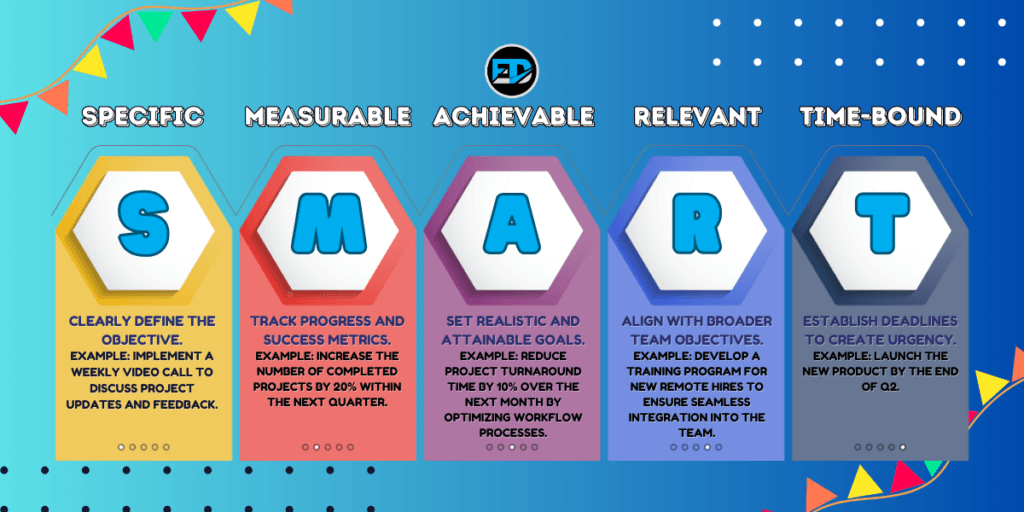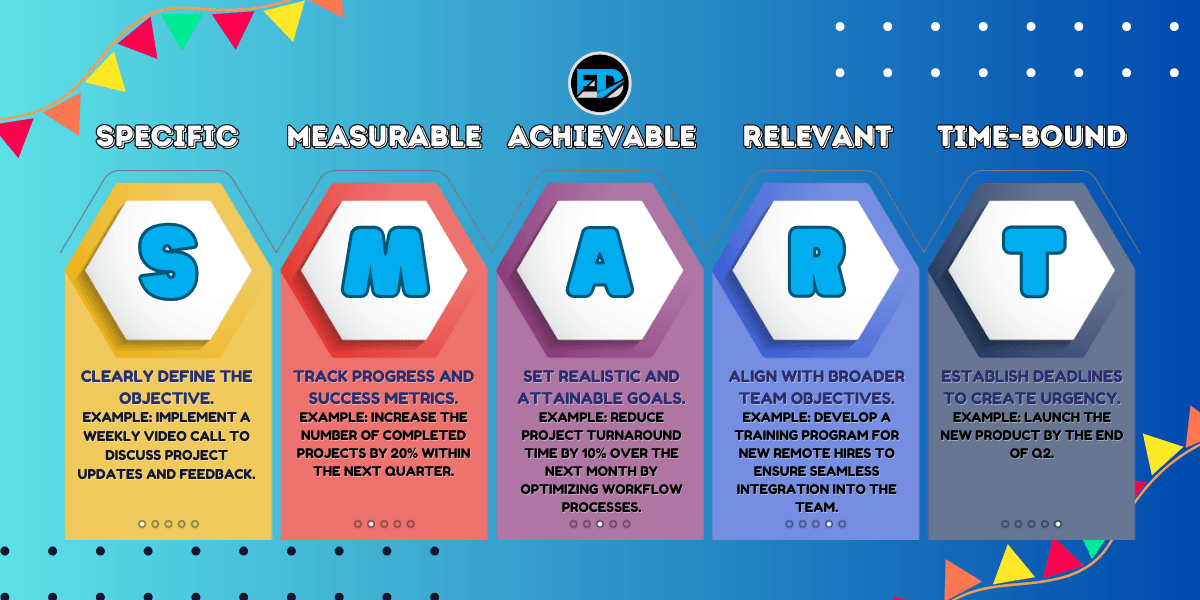In today’s rapidly evolving work environment, the ability to set and achieve goals effectively has become more crucial than ever. For remote teams, this necessity is magnified due to the unique challenges of distance and communication. One proven method to ensure that goals are clear, attainable, and impactful is the SMART framework. This article delves into the intricacies of setting SMART goals for remote teams, providing practical tips and insights to enhance productivity and cohesion.
Introduction
The transition to remote work has brought about a paradigm shift in how teams operate. With physical distance separating team members, the need for clear, actionable goals is paramount. Setting SMART goals—Specific, Measurable, Achievable, Relevant, Time-bound—ensures that everyone is on the same page, working towards common objectives with clarity and purpose. This guide explores how to effectively set SMART goals for remote teams, fostering an environment of accountability and success.
The Importance of SMART Goals for Remote Teams
Establishing SMART goals provides a structured approach to goal setting, which is especially beneficial for remote teams. Without the daily in-person interactions that traditional office settings offer, remote teams can easily lose focus. SMART goals help to:
- Enhance Clarity and Focus: Clear objectives reduce ambiguity, ensuring every team member understands their role and responsibilities.
- Boost Motivation and Engagement: Achievable goals provide motivation, while measurable milestones allow for regular celebrations of success.
- Improve Collaboration: Well-defined goals foster better communication and collaboration among team members.
- Ensure Accountability: Specific and time-bound goals hold team members accountable, promoting a culture of responsibility.

Specific: Defining Clear Objectives
The first step in setting SMART goals is to ensure they are specific. Vague goals can lead to confusion and a lack of direction. Specific goals should answer the following questions:
- What needs to be accomplished?
- Why is this goal important?
- Who is involved?
- Where will it be done?
- Which resources or limitations are involved?
For example, rather than setting a goal to “improve team communication,” a specific goal would be “implement a weekly video call to discuss project updates and feedback.”
Measurable: Tracking Progress and Success
Measurable goals allow teams to track their progress and determine when a goal has been achieved. This involves setting criteria for success. Questions to consider include:
- How much or how many?
- How will I know when it is accomplished?
An example of a measurable goal could be “increase the number of completed projects by 20% within the next quarter.”
Achievable: Setting Realistic Goals
Goals need to be realistic and attainable. Setting overly ambitious goals can lead to frustration and demotivation. To determine if a goal is achievable, consider:
- Do we have the resources and capabilities to achieve this goal?
- Is the goal realistic given the current constraints?
An achievable goal might be “reduce project turnaround time by 10% over the next month by optimizing workflow processes.”

Relevant: Aligning Goals with Team Objectives
Goals should be relevant and aligned with broader team objectives. This ensures that the efforts contribute to the overall success of the team and organization. Relevant goals answer the questions:
- Does this goal matter?
- Is it the right time?
- Does it align with other goals?
For instance, a relevant goal could be “develop a training program for new remote hires to ensure seamless integration into the team.”
Time-bound: Setting Deadlines
A goal without a deadline is a goal that can easily be postponed indefinitely. Time-bound goals establish a sense of urgency and help prioritize tasks. Consider:
- When does the goal need to be achieved?
- What can be done today, next week, next month?
An example of a time-bound goal is “launch the new product by the end of Q2.”
Implementing SMART Goals in Remote Teams
Successfully implementing SMART goals in remote teams requires a few additional considerations. Communication, technology, and regular check-ins play vital roles in this process.
Effective Communication
Clear and consistent communication is critical. Utilize various communication tools such as video conferencing, instant messaging, and project management software to keep everyone connected and informed. Schedule regular meetings to review progress and address any challenges.
Leveraging Technology
Technology is a remote team’s best friend. Project management tools like Asana, Trello, and Slack can help in tracking progress, assigning tasks, and maintaining transparency. These tools enable remote teams to stay organized and focused on their goals.
Regular Check-ins and Feedback
Frequent check-ins and feedback sessions are essential to ensure that everyone is aligned and any issues are promptly addressed. These sessions provide opportunities for team members to discuss progress, share insights, and recalibrate goals if necessary.

Conclusion
Setting SMART goals for remote teams is a powerful strategy to enhance productivity, motivation, and collaboration. By ensuring that goals are specific, measurable, achievable, relevant, and time-bound, remote teams can overcome the challenges of distance and work towards shared success. Leaders play a pivotal role in guiding their teams through this process, providing the necessary support and resources. With effective communication, the right technology, and regular check-ins, remote teams can achieve remarkable outcomes.
FAQ
SMART goals are specific, measurable, achievable, relevant, and time-bound objectives that provide clear direction and accountability.
SMART goals help remote teams stay focused, motivated, and aligned, despite the challenges of physical distance.
Define clear objectives by answering questions such as what, why, who, where, and which to eliminate ambiguity.
Project management tools like Asana, Trello, and Slack are effective for tracking progress and maintaining transparency.
Regular check-ins, such as weekly or bi-weekly meetings, are essential to review progress and make necessary adjustments.
Leaders provide direction, support, and resources, and regularly monitor progress to ensure the successful implementation of SMART goals.






Leave a Reply
You must be logged in to post a comment.